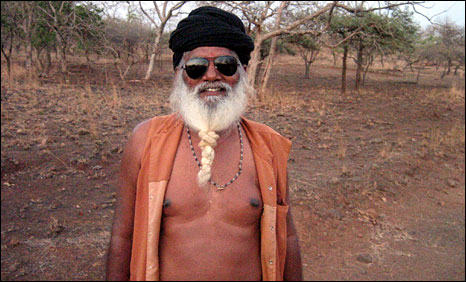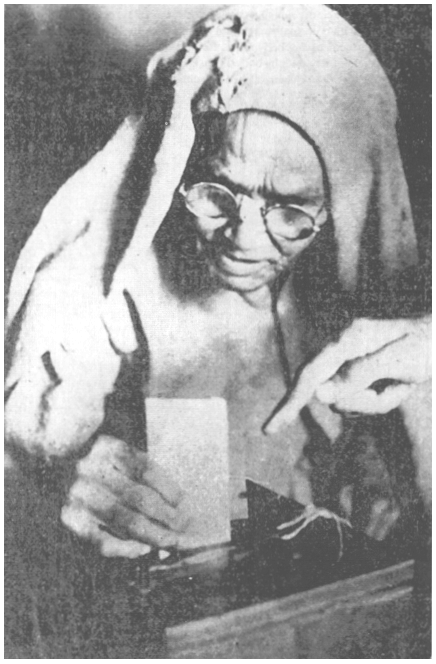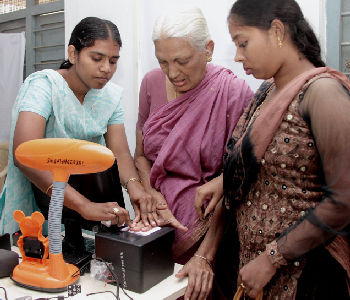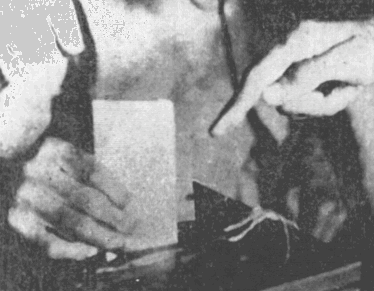Continuing on a series of posts on the Government of India’s early 2012 decision to keep “insecure” zones of the country like most of the Northeast (particularly its largest state, Assam) out of the Aadhaar/UID biometrics program, to be monitored instead by the more territorialized, security-focused National Population Register (NPR):
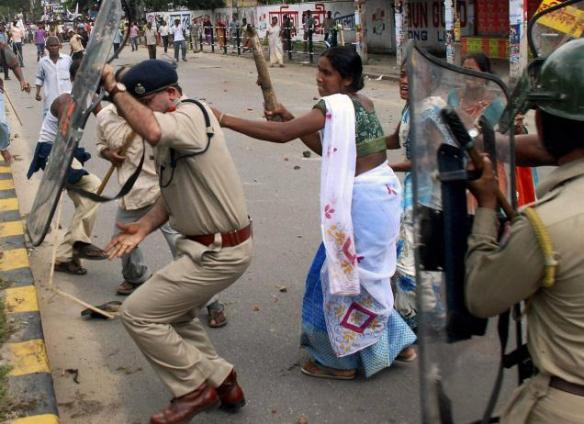
Life in the Security Zone: protesters against state evictions, June 2012, Guwahati, Assam
What Is and Is Not in the News
Assam is daily in the news, though the retraction of Aadhaar from the region receives almost no press. Given that Aadhaar has become central to the promissary return of contemporary governance, the card’s appearing to give back secure entitlements to electoral supporters of the ruling coalition (and of the rationalized “corporate-ethical” sector [more on this concept soon] granted increasing control over specific state functions), the withdrawal of this promissary return would seem to generate its own press. This is absent. I want to understand why.
The first answer is that Aadhaar has become so identified in Assam (and for many across India in relation to Assam in particular) with the “inflitration” of the Bangladeshi migrant into the citizenship and entitlement rolls that its removal generates little remorse among the dominant regional constiuencies of elite media, the media I at this point have access to via the Internet.
But one might expect the emergence of calls for a modified form of biometric registration, one that was not “universal” but separated citizens from mere residents in the dispensation of current entitlement and future promise. At this point I am going to argue that no such calls have emerged that are focused on the “proper” citizenry of Assam or at least no such calls seem to have been able to go public. I may well retract this claim if and when I can find substantial evidence to the contrary.
Such exclusive claims for rights in promissary citizenship in Assam are likely to be of two dominant kinds: rights in law [the Assamese resident and Indian citizen against the illegal migrant] and rights in nature [the Bodo autochthon against the non-Bodo stranger, the latter currently the illegal migrant]. But calls to redraft the form of Aadhaar to shore up these rights do not seem to have intensified with the state’s loss of easy access to UID.
The Assam-focused press is diverse, otherwise. It is devoted to registers of incivility and instability, of state violence and of state welfare in the face of civil violence. It seems both to support and to trouble the anti-migrant sentiment discussed in previous postings. Much national attention on Assam and its capital Guwahati has focused on the recent beating and forced-stripping of a girl in Guwahati this past July by a large group of jeering men, the event apparently captured on video. Many of the responses to the attack on this girl that I have seen on various media are complicit with a racialization of the Assamese as “backward” and somehow categorically unstable: in effect justifying the zonal distribution of modes of biometric control at stake in the division of the country between Security/NPR and Liberalization/UID.
There has been some press as well focused on resistance to government eviction drives against poor urban and rural slumdwellers occupying illegal “hutments.” The news photo above is of a piece with that genre.
None of these events are restricted to Assam–not communal killings, not sexualized violence against women, not the state policy of slum dispossession–but they form part of a mediascape affirming the state’s exceptional status and its exclusion, to use the first pass at a language I developed in the previous post, from the power zone of economic liberalization into the security zone [these terms are not conceptually adequate for many reasons, but for now the point is to focus on a zonal form of doubled or duplicated governance].
Two Orders of Contract?
Most of the documentation available online on Aadhaar in Assam is from the first, earlier moment, before January 2012, the moment when the biometric program’s promise for this marginal state had not been given over to the Security regime of NPR.
Information and reports at least via the Internet quickly dry up after January.
Perhaps the very nature of a security based enterprise like the NPR is that it produces a much smaller penumbra and far fewer traces of itself. Or to put it differently: both security interventions (like NPR) and liberalization interventions (like UID) now depend on a contractual relation between state agencies (like the ministries of home and of finance, respectively) and corporate sector companies to implement the new identity biometrics. But how contracts are established and entered into may differ between power zones and security zones. This post is a first effort to push myself to attend to the specificities of contract in the structuring of government: the emergent history of biometrics, in which twin national database regimes are being established in parallel, suggests that there is not a single pragmatics of contract, a single logic of governance, being crafted.
Having written this, I should note that I do not yet understand how the Interior Ministry’s NPR will work. It is tied to the Census, or has been, so part of the question is the organization of labor, capital, and control of the census over the next decade. I am in part assuming that security apparatuses, no less than other state functions, have throughout the world been given over to contract with privatized capital. But I should be cautious.
A second note of caution: the January 2012 entente between NPR and UID, between Security and Finance, between the Home Ministry and the Planning Commission, involved the powerful then Home Minister Chidambaram, who has recently again been given the Finance Ministry, a position he had earlier occupied. In other words, if the late 2011 struggle over the nation cum database focused on the tussle between these two ministries and presumably their distinct forms of governance over security and economy, how do we understand the movement back and forth of this powerful official?
Chidambaram aside, the very presence of two parallel such logics of governance and two parallel programs of biometric ID may suggest a second order of contract, not the contract between the state agency proposing and the private company executing one or the other mode of biometric inclusion but rather the contract governing the relation between two two orders or modes of registering people biometrically, of financial liberalization versus security.
What Was: Traces of the Earlier Promise of Aadhaar for Assam
The text for today is an RFQ, a Request for Quotation [that is a bid for contract] put out by the Government of Assam in the earlier phase of its relation to Aadhaar. For now I cite only a few small sections.

Invitation to Contract?
GOVERNMENT OF ASSAM DEPARTMENT OF PANCHAYAT & RURAL DEVELOPMENT
TENDER NO. – DPRD/P/183/09-10/127
REQUEST FOR QUOTATION: FOR SELECTION OF UID ENROLMENT AGENCIES FOR THE UID PROJECT (PHASE I) OF GOVT. OF ASSAM
Date of Release of RFQ: 24th Dec, 2010
Date of Pre bid meeting: 10th Jan, 2011, 1430 hrs
Last date of Submission of Bid: 21st Jan, 2011 (Up to 1500 hrs)
Date of Opening of Bid: 21st Jan, 2011 (1600 hrs)
TABLE OF CONTENTS:
Vol I: Instruction to Bidders
Vol II: Scope of Work
Vol III: Standard Contracts
Initially in the first phase, the UID project will be implemented in 5 (Five) districts of Assam, i.e Jorhat, Dibrugarh, Sonitpur, Sivasagar and Tinsukia. The Panchayat and Rural Development Deptt. will be Registrar for the districts of Sonitpur, Sivasagar and Tinsukia. Food and Civil supplies Deptt. would be Registrar for the project in Jorhat and Dibrugarh. Accordingly the districts have been clubbed in 2 schedules. The Registrar will implement the project in their districts block wise. Commissioner, P& RD as convener of the sub-committee for selection of Enrolment Agencies is inviting bids for both the schedules.
Under the project all KYR demographic and biometric data as per UIDAI standard would be captured from all residents. In addition data under KYR+ standard as detailed below would also be captured along with KYR data from residents.
The KYR + fields include –
1. Bank Account (which includes Post Office Account also)
2. Job Card No. under MGNREGA
3. RSBY No.
4. BPL (ID)
5. TIN No. (Census)
6. Ration Card No. (AAY/BPL/ FIC/ APL Card)
7. Profession (Service, Self Employed, Cultivator, Labour, Student etc.)
8. Panchayat Name.
N.B.: There might be addition of 4 to 6 more KYR+ fields in the data to be captured which will be notified later. The Project is expected to enroll around 69.26 lakhs residents [6.926 million] by 31st March 2012 (as per projected figure of 2010 population).
2.2 About UID Project
The Government of India (GoI) has embarked upon an ambitious initiative to provide a Unique Identification (UID) to every resident of India and has constituted the Unique Identification Authority of India (UIDAI) for this purpose. The timing of this initiative coincides with the increased focus of the GoI on social inclusion and development through massive investments in various social sector programs, and transformation in public services delivery through e-Governance programs. The UID has been envisioned as a means for residents to easily and effectively establish their identity, to any agency, anywhere in the country, without having to repeatedly produce identity documentation to agencies. The enrolment is voluntary, More details on the UIDAI and the strategy overview can be found on the website: http://www.uidai.gov.in
The widespread implementation of the UID project needs the reach and flexibility to enroll residents across the country. To achieve this, the UIDAI is following a multiple registrar approach and proposes to partner with a variety of agencies and service providers (acting as Registrars, Sub-registrars and Enrolling Agencies) to enroll residents for UID. By participating in enrolling residents, registrars and enrolment agencies across the country would be part of a truly historic exercise, one which can make our welfare systems far more accessible and inclusive of the poor, and also permanently transform service delivery in India.
In this context, the Registrars shall engage enrolment agencies empanelled by UIDAI for carrying out the various functions and activities related to UID enrolment such as setting up of enrolment centers, undertaking collection of demographic and biometric data for UID enrollment and any other data required by the Registrar for the effective implementation of their projects. This Request for Quotation document is intended to invite bids from only those agencies which are empanelled by UIDAI for undertaking demographic and biometric data collection for enrolment of residents.
That was the prefactory material in the RFQ. 3 quick points, bearing in mind that these suggestions about variant logics of contract are very tentative on my part and far from fleshed out as a conceptual field:
1) Throughout this blog, I have been fascinated by the diagnosis of corruption in history at the core of UID biometrics, that of duplication. The awarding of contracts is among the more important sites of corruption globally and marks many previous and still simmering Indian corruption cases. So the question of variant pragmatics or logics of contract with which I began also raises a question of the “corrupt” duplication of these. Putting it more baldly: when is the invitation within the form of the RFQ in bad faith? How in practice are contracts awarded, entered into, monitored, and broken? If as in many cases of state contracts, the RFQ is a formality and the decision as to which company is chosen is determined by other means (so-called cronyism or what in India is usually called “the nexus,” for example), might we speak of the actual contract as a “duplicate” of the fair and formal contract promised by the RFQ?
2) This particular Assamese invitation [pre-January 2012] to contract may be in bad faith in a second way. Presumably, the aggressive rolling out of UID noted in this document was later shelved with Assam being declared proper not to UID but to NPR: companies invited to bid, and in so doing to invest in becoming registrars, were thus left without a growing market of persons considered proper to UID registration.
3) The document refers to KYR and NYR+ as two sets of information fields that UIDAI-contracted companies collect. From the last post’s documentation, we know a primary difference of UIDAI and NPR is that the latter will collect far more information. In the terms of territorialization and deterritorialization used earlier, UIDAI has more of a deterritorializing imperative.
KYR often stands for Know Your Resident. It is one of a proliferating series in corporate jargon of what we might call the KYX imperatives: Know Your ——. Know Your Customer, Know Your Client, and so forth. The form has been taken to with a vengeance by both business and government agencies in Anglophone India. On the web, one finds sites devoted to Know Your Mobile India, Know Your Visa, Know Your Assessing Officer, and many dozen others. The many ID numbers one receives in moving through the Indian bureaucratic and financial landscape can be accessed through KYX sites: thus Know Your PAN, Know Your TAN, and so forth. There are a range of sites named as Know Your India.
Know Your Resident is an important component of Aadhaar’s relation to territory and its ability to minimize the number of locational fields in service of its vision of liberalization and labor and entitlement rationalization. One apparently non-official site notes: “The strong authentication that the UIDAI will offer, combined with its KYR standards, can remove the need for such individual KYC [Know Your Customer] by banks for basic, no-frills accounts. It will thus vastly reduce the documentation the poor are required to produce for a bank account, and significantly bring down KYC costs for banks. The UIDAI will ensure that the Know Your Resident (KYR) standards don’t become a barrier for enrolling the poor, and will devise suitable procedures to ensure their inclusion without compromising the integrity of the data.”
Again, “Resident” like “Citizen” is effectively placed under erasure by UID/Aadhaar. That is, Aadhaar uses the promise of biometrics to produce a political subject that is resists nomination either as citizen or non-citizen, and yet, the opposition does not go away but hovers in much of the positive and negative discussion of the program. Aadhaar promises both to deterritorialize entitlements, severing the link of access to state programs from the natal or family village and all of the regressive entailments of native place, and to create effective territorialization for Banking, in the sense that the biometric “Resident” will somehow provide the trustworthiness enabling banks to advance credit to marginal actors. How exactly a subject is produced both not in place and in place, both as citizen and as resident, is I think a matter for engaged observation, aka “fieldwork.”
